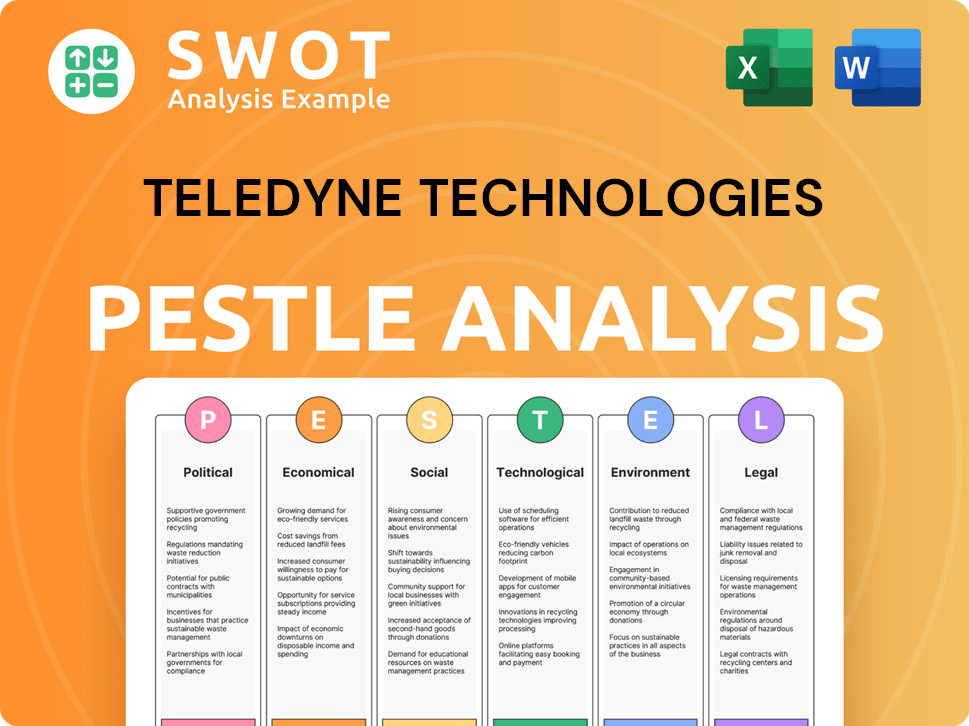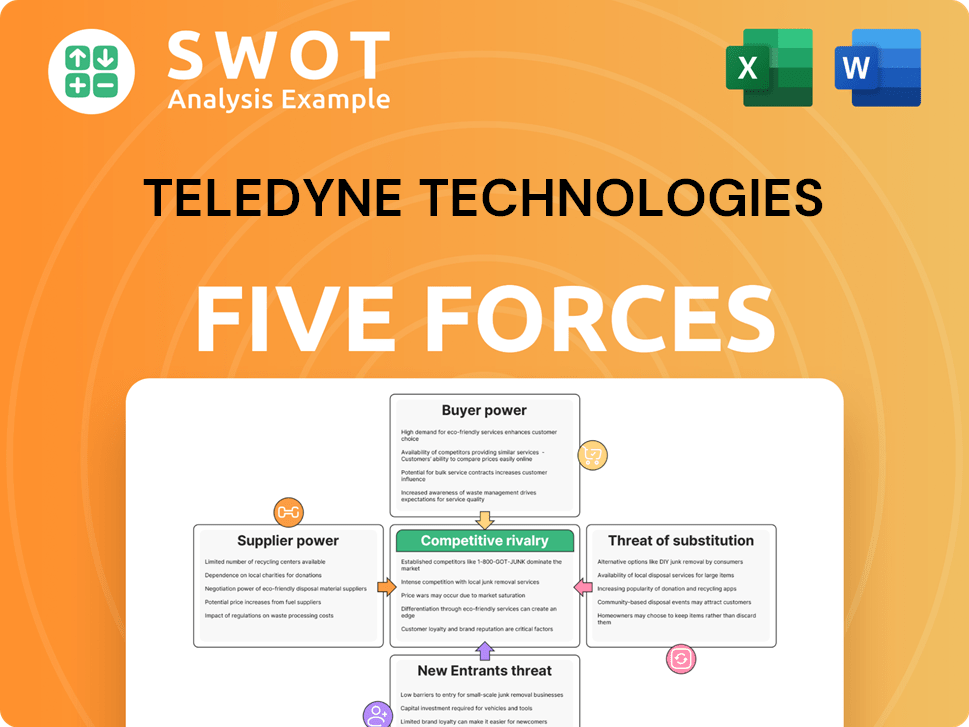Teledyne Technologies Bundle
How Does Teledyne Technologies Stack Up Against Its Rivals?
Teledyne Technologies, a $23.48 billion giant, is making waves with its cutting-edge technologies. With record-breaking Q1 2025 sales and strategic acquisitions, the company's growth trajectory is undeniable. But in a fiercely competitive landscape, how does Teledyne truly fare against its rivals?

To understand Teledyne's position, we must delve into its Teledyne Technologies SWOT Analysis and the broader competitive environment. This analysis will explore Teledyne's market share, industry analysis, and business strategy, revealing its competitive advantages and challenges. We will also examine who are Teledyne Technologies' main rivals and how its financial performance compares, providing a comprehensive view of its future outlook and strategic initiatives.
Where Does Teledyne Technologies’ Stand in the Current Market?
Teledyne Technologies holds a strong market position, operating across four key segments: Instrumentation, Digital Imaging, Aerospace and Defense Electronics, and Engineered Systems. The company's diverse portfolio and strategic focus have enabled it to maintain a competitive edge in various sectors. Understanding the Teledyne Technologies competitive landscape is crucial for investors and stakeholders.
In Q1 2025, Teledyne Technologies reported record net sales of $1,449.9 million, a 7.4% increase compared to Q1 2024. This growth reflects the company's ability to capitalize on market opportunities and strengthen its market position. The company's consistent financial performance underscores its resilience and strategic alignment within its core operating segments.
The company's financial health is robust, with a GAAP operating margin of 17.9% and a non-GAAP operating margin of 22.0% in Q1 2025. This strong financial performance is further supported by a solid balance sheet, with an S&P Global Ratings-adjusted leverage of 1.5x at the end of 2024. For more insights into the company's structure, you can explore the Owners & Shareholders of Teledyne Technologies.
The Digital Imaging segment, the largest for Teledyne Technologies, saw a 2.2% increase in net sales to $757.0 million in Q1 2025. This growth was primarily driven by increased sales of commercial infrared imaging components and surveillance systems. This segment's performance is a key indicator of the company's overall market strength.
The Instrumentation segment experienced a 3.9% rise in net sales, reaching $343.3 million. This growth was largely due to strong marine instrumentation sales, benefiting from the recovery in offshore energy markets and robust subsea defense-related sales. The segment's performance highlights Teledyne Technologies' ability to adapt to market dynamics.
The Aerospace and Defense Electronics segment saw a substantial 30.6% increase in net sales, reaching $242.5 million. This significant growth was primarily driven by increased defense electronics sales. This segment's performance reflects the company's strong position in the defense market.
The Engineered Systems segment grew by 14.9% to $107.1 million. This increase was driven by higher sales of electronic manufacturing services products. The segment's performance demonstrates the company's ability to diversify its offerings and capitalize on emerging opportunities.
The United States remains Teledyne Technologies' largest market, accounting for 70% of total sales between 2022 and 2024. The company also has significant operations in Canada, the United Kingdom, and Western and Northern Europe. This geographical diversification supports its overall market position and resilience.
- Teledyne market share is significantly influenced by its U.S. sales.
- Teledyne industry analysis reveals a focus on high-growth sectors.
- Teledyne business strategy includes organic growth and strategic acquisitions.
- The company anticipates modest organic revenue growth of about 3%-5% in 2025.
Teledyne Technologies SWOT Analysis
- Complete SWOT Breakdown
- Fully Customizable
- Editable in Excel & Word
- Professional Formatting
- Investor-Ready Format

Who Are the Main Competitors Challenging Teledyne Technologies?
The Teledyne Technologies operates in a highly competitive environment, facing both direct and indirect Teledyne competitors across its diverse business segments. Understanding the competitive landscape is crucial for evaluating its market position and strategic initiatives. The company's success is influenced by its ability to differentiate itself from rivals and capitalize on growth opportunities within its various sectors.
Teledyne's competitive dynamics are shaped by a combination of factors, including technological innovation, market trends, and strategic acquisitions. The company's performance is often benchmarked against its key rivals, and its financial results are closely watched by investors and industry analysts. Analyzing the competitive landscape provides insights into Teledyne's strengths, weaknesses, and potential for future growth.
Teledyne Technologies faces competition from a range of companies, depending on the specific segment. The company's diversified portfolio means it competes in multiple markets, each with its own set of key players. Recent acquisitions and strategic moves further shape the competitive environment, impacting Teledyne's market share and overall performance.
In the broader aerospace and defense industry, Teledyne's main rivals include TransDigm Group (TDG), General Dynamics (GD), and Northrop Grumman (NOC).
For instrumentation and electronic components, Teledyne competes with AMETEK, Keysight Technologies, Arrow Electronics, and Sensata Technologies.
In the imaging, semiconductor, and quantum technologies space, Teledyne, particularly through its Teledyne e2v subsidiary, faces competition from Infineon, Semtech, and Analog Devices.
In the inspection instruments sector, Teledyne's revenue growth in Q3 2024 lagged behind competitors such as Faro (U.S.) and Carl Zeiss (Germany), indicating intense competition in this area.
Other notable competitors include HEICO (HEI), Curtiss-Wright (CW), Textron (TXT), Huntington Ingalls Industries (HII), Kratos Defense & Security Solutions (KTOS), AeroVironment (AVAV), and Spirit AeroSystems (SPR).
Jenoptik is expected to achieve an operating revenue of approximately $1.5 billion in 2025, highlighting the competitive intensity.
Teledyne's strategic moves, such as acquisitions, also influence the competitive landscape. For instance, the acquisition of Micropac in December 2024 and select aerospace and defense electronics businesses from Excelitas Technologies Corp. in February 2025, help Teledyne strengthen its product offerings and market position against its rivals. For an in-depth look at Teledyne's business model, you can read more about it in Revenue Streams & Business Model of Teledyne Technologies.
The Teledyne Technologies operates in a competitive environment with diverse rivals across its business segments.
- Key competitors include TransDigm Group, General Dynamics, AMETEK, and others.
- Teledyne's acquisitions, such as Micropac, impact its market position.
- The competitive landscape is shaped by technological innovation, market trends, and strategic moves.
- Understanding the Teledyne competitors is crucial for assessing its market position and future growth.
Teledyne Technologies PESTLE Analysis
- Covers All 6 PESTLE Categories
- No Research Needed – Save Hours of Work
- Built by Experts, Trusted by Consultants
- Instant Download, Ready to Use
- 100% Editable, Fully Customizable

What Gives Teledyne Technologies a Competitive Edge Over Its Rivals?
The competitive landscape for Teledyne Technologies is shaped by its unique strengths in providing enabling technologies for industrial growth markets. The company's focus on sensing, transmitting, and analyzing information, particularly in demanding environments, sets it apart from many competitors. Strategic acquisitions and a vertically integrated portfolio contribute to its robust market position.
Teledyne Technologies distinguishes itself through its proprietary technologies and diverse product portfolio. The company's commitment to innovation, demonstrated by significant R&D spending, and its strong customer relationships, are key to its competitive edge. This approach allows it to maintain a strong position in the industry, especially in sectors requiring high reliability and performance.
Teledyne Technologies' competitive advantages stem from its specialized offerings and strategic moves. The company's ability to integrate various technologies and its focus on long-term customer relationships contribute to its resilience and growth potential. The company's history and evolution are detailed in a brief history of Teledyne Technologies.
One of Teledyne Technologies' key strengths is its vertically integrated portfolio. This includes industrial and scientific imaging technology, providing advanced tools and vision solutions. This integrated approach allows for a competitive advantage through innovation and comprehensive offerings.
Teledyne Technologies invests heavily in research and development, with $687 million spent in 2024. This investment supports continuous technological innovation and helps mitigate substitution threats. The company's commitment to R&D drives growth and maintains its competitive edge.
Teledyne Technologies benefits from long-term customer relationships, with an average duration of 12.4 years and an 87.3% repeat customer rate. These strong relationships indicate customer loyalty and provide a stable foundation for future growth. This loyalty is a significant advantage in the competitive landscape.
Strategic acquisitions, such as Micropac and Qioptiq in early 2025, bolster Teledyne Technologies' market position and product offerings. The company's diversified business model, with contributions from both commercial and government sectors, provides a stable revenue stream and reduces reliance on any single market.
Teledyne Technologies holds several competitive advantages that contribute to its strong market position. These advantages include its vertically integrated portfolio, significant R&D spending, and long-term customer relationships. The company's strategic acquisitions and diversified business model further enhance its ability to compete.
- Proprietary technologies and a vertically integrated portfolio, including Teledyne DALSA, e2v, and FLIR IIS.
- Significant R&D investment, totaling $687 million in 2024, driving continuous innovation.
- Strong customer loyalty, with an average relationship of 12.4 years and an 87.3% repeat customer rate.
- Strategic acquisitions, such as Micropac and Qioptiq in early 2025, expanding product offerings.
- A diversified business model with contributions from both commercial and government sectors.
Teledyne Technologies Business Model Canvas
- Complete 9-Block Business Model Canvas
- Effortlessly Communicate Your Business Strategy
- Investor-Ready BMC Format
- 100% Editable and Customizable
- Clear and Structured Layout

What Industry Trends Are Reshaping Teledyne Technologies’s Competitive Landscape?
The competitive landscape for Teledyne Technologies is shaped by dynamic industry trends, presenting both challenges and opportunities. The company benefits from growth in medical imaging, pharmaceutical research, defense, and space sectors. However, challenges include potential impacts from tariffs and trade restrictions and concerns about government spending cuts. Teledyne's strategic approach focuses on leveraging these trends while mitigating risks to drive growth and maintain a strong market position.
Teledyne's industry position is influenced by its ability to adapt to technological advancements and market demands. The company's financial performance is closely tied to its ability to innovate and integrate strategic acquisitions. The future outlook involves expanding product lines, strategic partnerships, and reaching sales targets, reflecting a proactive approach to maintaining a competitive edge. Explore the Growth Strategy of Teledyne Technologies for more insights.
Key industry trends include increased demand for high-precision measurement solutions and advancements in metrology technologies. Growing markets in medical imaging and pharmaceutical research also drive growth. The recovery in offshore energy markets and strong defense and space sectors are also beneficial. Teledyne is positioned to capitalize on these trends through its diverse product offerings and strategic innovations.
Teledyne faces challenges from tariffs and trade restrictions, with potential annual costs of approximately $100 million, particularly related to China. There are also concerns regarding the recovery of shorter-cycle businesses and potential government spending cuts, especially in NASA-related programs. Softness in the Digital Imaging segment due to lower customer capital expenditure also poses a challenge.
Significant growth opportunities exist for Teledyne by expanding product lines and services, especially in medical imaging and pharmaceutical research. Strategic acquisitions and mergers, like the recent purchases of Micropac and Qioptiq, enhance market competitiveness. The company's strong cash flow, with over $1 billion expected annually, supports continued acquisitions and capital allocation.
Teledyne is focused on research and development and exploring strategic partnerships to maintain its competitive edge. The company aims to reach $6 billion in sales by 2025, driven by organic growth and acquisitions. Innovations like configurable 3U VPX power supply cards for LEO satellites and wideband RF switches are key initiatives.
Teledyne's strong cash flow, with over $1 billion expected annually, provides flexibility for acquisitions and investments. The company's goal of achieving $6 billion in sales by 2025 highlights its ambitious growth targets. These financial metrics underscore Teledyne's commitment to sustained growth and market leadership.
- Teledyne anticipates reaching $6 billion in sales by 2025.
- The company's strong cash flow supports strategic acquisitions and investments.
- Recent acquisitions, such as Micropac and Qioptiq, enhance market competitiveness.
- Teledyne is investing in R&D and strategic partnerships.
Teledyne Technologies Porter's Five Forces Analysis
- Covers All 5 Competitive Forces in Detail
- Structured for Consultants, Students, and Founders
- 100% Editable in Microsoft Word & Excel
- Instant Digital Download – Use Immediately
- Compatible with Mac & PC – Fully Unlocked

Related Blogs
- What are Mission Vision & Core Values of Teledyne Technologies Company?
- What is Growth Strategy and Future Prospects of Teledyne Technologies Company?
- How Does Teledyne Technologies Company Work?
- What is Sales and Marketing Strategy of Teledyne Technologies Company?
- What is Brief History of Teledyne Technologies Company?
- Who Owns Teledyne Technologies Company?
- What is Customer Demographics and Target Market of Teledyne Technologies Company?
Disclaimer
All information, articles, and product details provided on this website are for general informational and educational purposes only. We do not claim any ownership over, nor do we intend to infringe upon, any trademarks, copyrights, logos, brand names, or other intellectual property mentioned or depicted on this site. Such intellectual property remains the property of its respective owners, and any references here are made solely for identification or informational purposes, without implying any affiliation, endorsement, or partnership.
We make no representations or warranties, express or implied, regarding the accuracy, completeness, or suitability of any content or products presented. Nothing on this website should be construed as legal, tax, investment, financial, medical, or other professional advice. In addition, no part of this site—including articles or product references—constitutes a solicitation, recommendation, endorsement, advertisement, or offer to buy or sell any securities, franchises, or other financial instruments, particularly in jurisdictions where such activity would be unlawful.
All content is of a general nature and may not address the specific circumstances of any individual or entity. It is not a substitute for professional advice or services. Any actions you take based on the information provided here are strictly at your own risk. You accept full responsibility for any decisions or outcomes arising from your use of this website and agree to release us from any liability in connection with your use of, or reliance upon, the content or products found herein.